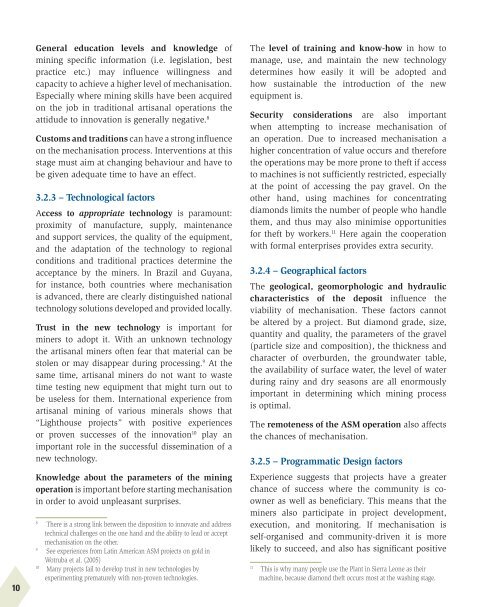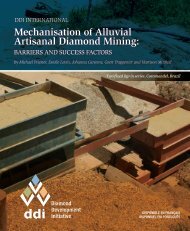Mechanisation-Alluvial-Artisanal-Diamond-Mining
Mechanisation-Alluvial-Artisanal-Diamond-Mining
Mechanisation-Alluvial-Artisanal-Diamond-Mining
You also want an ePaper? Increase the reach of your titles
YUMPU automatically turns print PDFs into web optimized ePapers that Google loves.
10<br />
General education levels and knowledge of<br />
mining specific information (i.e. legislation, best<br />
practice etc.) may influence willingness and<br />
capacity to achieve a higher level of mechanisation.<br />
Especially where mining skills have been acquired<br />
on the job in traditional artisanal operations the<br />
attidude to innovation is generally negative. 8<br />
Customs and traditions can have a strong influence<br />
on the mechanisation process. Interventions at this<br />
stage must aim at changing behaviour and have to<br />
be given adequate time to have an effect.<br />
3.2.3 – Technological factors<br />
Access to appropriate technology is paramount:<br />
proximity of manufacture, supply, maintenance<br />
and support services, the quality of the equipment,<br />
and the adaptation of the technology to regional<br />
conditions and traditional practices determine the<br />
acceptance by the miners. In Brazil and Guyana,<br />
for instance, both countries where mechanisation<br />
is advanced, there are clearly distinguished national<br />
technology solutions developed and provided locally.<br />
Trust in the new technology is important for<br />
miners to adopt it. With an unknown technology<br />
the artisanal miners often fear that material can be<br />
stolen or may disappear during processing. 9 At the<br />
same time, artisanal miners do not want to waste<br />
time testing new equipment that might turn out to<br />
be useless for them. International experience from<br />
artisanal mining of various minerals shows that<br />
“Lighthouse projects” with positive experiences<br />
or proven successes of the innovation 10 play an<br />
important role in the successful dissemination of a<br />
new technology.<br />
Knowledge about the parameters of the mining<br />
operation is important before starting mechanisation<br />
in order to avoid unpleasant surprises.<br />
8<br />
There is a strong link between the disposition to innovate and address<br />
technical challenges on the one hand and the ability to lead or accept<br />
mechanisation on the other.<br />
9<br />
See experiences from Latin American ASM projects on gold in<br />
Wotruba et al. (2005)<br />
10<br />
Many projects fail to develop trust in new technologies by<br />
experimenting prematurely with non-proven technologies.<br />
The level of training and know-how in how to<br />
manage, use, and maintain the new technology<br />
determines how easily it will be adopted and<br />
how sustainable the introduction of the new<br />
equipment is.<br />
Security considerations are also important<br />
when attempting to increase mechanisation of<br />
an operation. Due to increased mechanisation a<br />
higher concentration of value occurs and therefore<br />
the operations may be more prone to theft if access<br />
to machines is not sufficiently restricted, especially<br />
at the point of accessing the pay gravel. On the<br />
other hand, using machines for concentrating<br />
diamonds limits the number of people who handle<br />
them, and thus may also minimise opportunities<br />
for theft by workers. 11 Here again the cooperation<br />
with formal enterprises provides extra security.<br />
3.2.4 – Geographical factors<br />
The geological, geomorphologic and hydraulic<br />
characteristics of the deposit influence the<br />
viability of mechanisation. These factors cannot<br />
be altered by a project. But diamond grade, size,<br />
quantity and quality, the parameters of the gravel<br />
(particle size and composition), the thickness and<br />
character of overburden, the groundwater table,<br />
the availability of surface water, the level of water<br />
during rainy and dry seasons are all enormously<br />
important in determining which mining process<br />
is optimal.<br />
The remoteness of the ASM operation also affects<br />
the chances of mechanisation.<br />
3.2.5 – Programmatic Design factors<br />
Experience suggests that projects have a greater<br />
chance of success where the community is coowner<br />
as well as beneficiary. This means that the<br />
miners also participate in project development,<br />
execution, and monitoring. If mechanisation is<br />
self-organised and community-driven it is more<br />
likely to succeed, and also has significant positive<br />
11<br />
This is why many people use the Plant in Sierra Leone as their<br />
machine, because diamond theft occurs most at the washing stage.



